

Rene Gagnon. René Arthur Gagnon (March 7, 1925 – October 12, 1979) was one of the United States Marines immortalized by Joe Rosenthal's famous World War II photograph Raising the Flag on Iwo Jima.

Brian Haig. Early life and family[edit] Haig's father was former U.S.
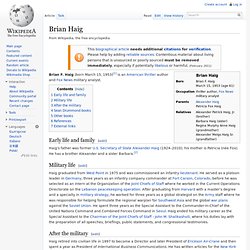
Secretary of State Alexander Haig (1924–2010); his mother is Patricia (née Fox). He has a brother Alexander and a sister Barbara.[2] Roy Kellerman. Roy Herman Kellerman (March 14, 1915 – March 22, 1984) was a U.S.
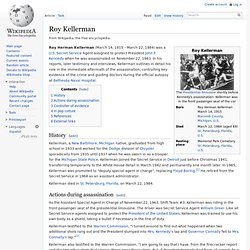
Secret Service Agent assigned to protect President John F. Kennedy when he was assassinated on November 22, 1963. In his reports, later testimony and interviews, Kellerman outlines in detail his role in the immediate aftermath of the assassination, controlling key evidence of the crime and guiding doctors during the official autopsy at Bethesda Naval Hospital. History[edit] Kellerman, a New Baltimore, Michigan native, graduated from high school in 1933 and worked for the Dodge division of Chrysler sporadically from 1935 until 1937 when he was sworn in as a trooper for the Michigan State Police. Kellerman died in St. Michael Hayden (general) He was Director of the National Security Agency (NSA) from 1999 to 2005.
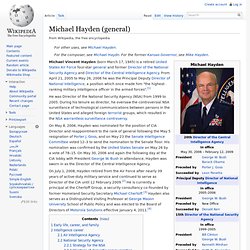
During his tenure as director, he oversaw the controversial NSA surveillance of technological communications between persons in the United States and alleged foreign terrorist groups, which resulted in the NSA warrantless surveillance controversy. On May 8, 2006, Hayden was nominated for the position of CIA Director and reappointment to the rank of general following the May 5 resignation of Porter J.
Goss, and on May 23 the Senate Intelligence Committee voted 12–3 to send the nomination to the Senate floor. His nomination was confirmed by the United States Senate on May 26 by a vote of 78–15. On May 30, 2006 and again the following day at the CIA lobby with President George W. Michael Vincent Hayden was born on St. He went to St. He was commissioned through University of Pittsburgh's Air Force Reserve Officer Training Corps program.[6] Hayden entered active military service in 1969.
Articles. Alfred von Schlieffen. Alfred Graf von Schlieffen. Alfred von Tirpitz. Grand Admiral Alfred von Tirpitz (March 19, 1849 – March 6, 1930) was a German Admiral, Secretary of State of the German Imperial Naval Office, the powerful administrative branch of the German Imperial Navy from 1897 until 1916.
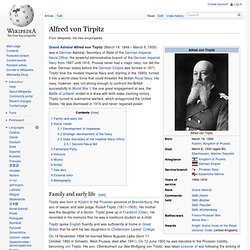
Prussia never had a major navy, nor did the other German states before the German Empire was formed in 1871. Tirpitz took the modest Imperial Navy and, starting in the 1890s, turned it into a world-class force that could threaten the British Royal Navy. Antonio López de Santa Anna. Antonio de Padua María Severino López de Santa Anna y Pérez de Lebrón (21 February 1794 – 21 June 1876),[1] often known as Santa Anna[2] or López de Santa Anna and sometimes called "the Napoleon of the West", was a Mexican politician and general who greatly influenced early Mexican politics and government.
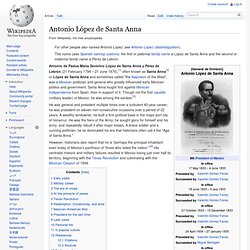
Santa Anna fought first against Mexican independence from Spain, then in support of it. Though not the first caudillo (military leader) of Mexico, he was among the earliest.[3] He was general and president multiple times over a turbulent 40-year career; he was president on eleven non-consecutive occasions over a period of 22 years. A wealthy landowner, he built a firm political base in the major port city of Veracruz. Philip Sheridan. Early life[edit] Brevet Second Lieutenant Philip Sheridan Sheridan claimed he was born in Albany, New York,[1] the third child of six by John and Mary Meenagh Sheridan, immigrants from the parish of Killinkere, County Cavan, Ireland.
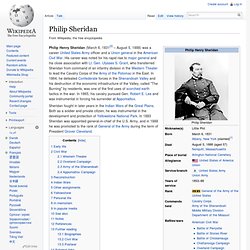
Paul Tibbets. Tibbets returned to the United States in February 1943 to help with the development of the Boeing B-29 Superfortress bomber.
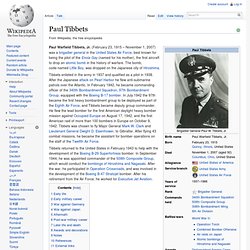
Louis-Gabriel Suchet. Louis Gabriel Suchet, 1st Duc d'Albufera (2 March 1770 – 3 January 1826) was a Marshal of France and one of Napoleon's most brilliant generals.
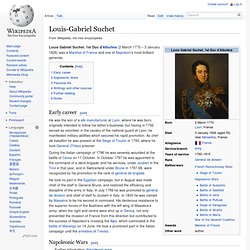
Joseph Stilwell. Alexander Vandegrift. Biography[edit] Alexander Archer Vandegrift was born on March 13, 1887 in the small town of Charlottesville, Virginia where his father of Dutch descent was an architect and contractor.[3] Young Vandegrift, known as "Archer" in his boyhood,[3] had an interest in the military – both from reading military history novels and from stories of ancestors who fought in various wars.[4] He attended the University of Virginia for three years; then received his commission in the U.S.
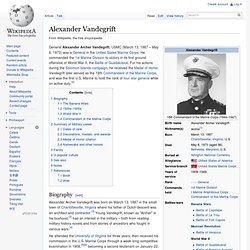
Marine Corps through a week-long competitive examination in 1908,[5][6] becoming a second lieutenant on January 22, 1909. Yuri Gagarin. Gagarin became an international celebrity, and was awarded many medals and titles, including Hero of the Soviet Union, the nation's highest honour. Vostok 1 marked his only spaceflight, but he served as backup crew to the Soyuz 1 mission (which ended in a fatal crash). Gagarin later became deputy training director of the Cosmonaut Training Centre outside Moscow, which was later named after him. Gagarin died in 1968 when the MiG-15 training jet he was piloting crashed. Shivaji. Shivaji Bhonsle (Marathi [ʃiʋaˑɟiˑ bʱoˑs(ə)leˑ]; c. 1627/1630[2] – 3 April 1680), was an Indian warrior king. An aristocrat of the Bhonsle Maratha clan, Shivaji, in 1674, carved out an enclave from the declining Adilshahi sultanate of Bijapur that formed the genesis of an independent Maratha kingdom with Raigad as its capital.
Shivaji established a competent and progressive civil rule with the help of a disciplined military and well-structured administrative organisations. He innovated military tactics, pioneering the guerilla warfare methods (Shiva sutra or ganimi kava), which leveraged strategic factors like geography, speed, and surprise and focused pinpoint attacks to defeat his larger and more powerful enemies. From a small contingent of 2,000 soldiers inherited from his father, Shivaji created a force of 100,000 soldiers; he built and restored strategically located forts both inland and coastal to safeguard his territory.
Early life[edit] Shivaji's birthplace on Shivneri Fort. Paul von Lettow-Vorbeck.